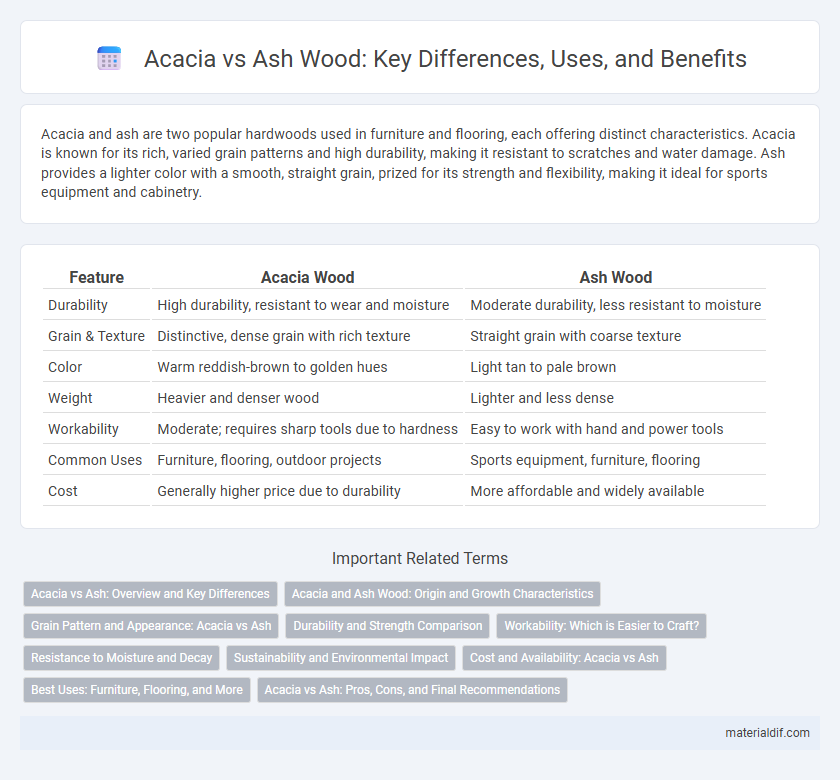Acacia and ash are two popular hardwoods used in furniture and flooring, each offering distinct characteristics. Acacia is known for its rich, varied grain patterns and high durability, making it resistant to scratches and water damage. Ash provides a lighter color with a smooth, straight grain, prized for its strength and flexibility, making it ideal for sports equipment and cabinetry.
Table of Comparison
| Feature | Acacia Wood | Ash Wood |
|---|---|---|
| Durability | High durability, resistant to wear and moisture | Moderate durability, less resistant to moisture |
| Grain & Texture | Distinctive, dense grain with rich texture | Straight grain with coarse texture |
| Color | Warm reddish-brown to golden hues | Light tan to pale brown |
| Weight | Heavier and denser wood | Lighter and less dense |
| Workability | Moderate; requires sharp tools due to hardness | Easy to work with hand and power tools |
| Common Uses | Furniture, flooring, outdoor projects | Sports equipment, furniture, flooring |
| Cost | Generally higher price due to durability | More affordable and widely available |
Acacia vs Ash: Overview and Key Differences
Acacia and Ash are prominent hardwoods with distinct characteristics; Acacia wood is known for its rich, warm hues and high oil content that makes it naturally water-resistant, while Ash features a lighter color and notable strength and flexibility, making it ideal for sports equipment. Acacia's dense grain pattern offers excellent durability and resistance to wear, contrasting with Ash's open grain texture that provides a smooth finish and shock absorption. These differences make Acacia suitable for outdoor furniture and flooring, whereas Ash is often preferred in tool handles and indoor furnishings.
Acacia and Ash Wood: Origin and Growth Characteristics
Acacia wood originates primarily from Australia and Africa, characterized by fast growth and dense, durable hardwood ideal for furniture and flooring. Ash wood, native to North America and Europe, grows readily in temperate climates and features a lighter color with excellent flexibility and shock resistance. Both woods exhibit distinct grain patterns and growth rates influencing their specific uses in woodworking and construction.
Grain Pattern and Appearance: Acacia vs Ash
Acacia wood features a rich, varied grain pattern with swirls and contrasting tones, creating a warm and exotic appearance. Ash wood displays a more uniform, straight grain with a light, creamy color, giving it a clean and classic look. The distinctive grain patterns of Acacia make it ideal for decorative pieces, while Ash's consistent texture suits modern and minimalist designs.
Durability and Strength Comparison
Acacia wood exhibits exceptional durability, characterized by its high resistance to decay and insect attacks, making it ideal for both indoor and outdoor applications. Ash wood is renowned for its superior strength and elasticity, offering excellent shock resistance, which is why it is commonly used in tool handles and sports equipment. While acacia surpasses ash in moisture resistance, ash's tensile strength provides greater structural reliability under mechanical stress.
Workability: Which is Easier to Craft?
Acacia wood offers moderate workability with a fine, even grain that responds well to hand and machine tools, making it suitable for furniture and decorative items. Ash wood is highly valued for its excellent workability due to its straight grain and consistent texture, allowing for smooth cuts, sanding, and finishing. Craftsmen often prefer ash over acacia for projects requiring intricate shapes and durability combined with ease of machining.
Resistance to Moisture and Decay
Acacia wood exhibits superior resistance to moisture and decay due to its dense grain structure and natural oils that inhibit fungal growth, making it ideal for outdoor furniture and high-humidity environments. Ash wood, while strong and flexible, is more prone to moisture absorption and decay without proper sealing, limiting its use in damp conditions. The natural durability of acacia wood provides a longer lifespan compared to ash when exposed to moisture and decay risks.
Sustainability and Environmental Impact
Acacia wood is recognized for its rapid growth and renewable properties, making it a more sustainable choice compared to Ash, which grows slower and requires more time to replenish. The dense grain of Acacia also contributes to its durability, reducing the need for frequent replacement and minimizing environmental strain. Sustainable forestry practices in Acacia cultivation further reduce carbon footprint and promote biodiversity preservation.
Cost and Availability: Acacia vs Ash
Acacia wood generally commands a higher price compared to ash due to its durability and exotic appeal, often making it less available in local markets. Ash is more widely accessible and affordable, thanks to its abundance and faster growth rate, making it a cost-effective option for furniture and flooring. Availability of acacia tends to be limited to specialty suppliers, while ash is commonly stocked by major lumber distributors.
Best Uses: Furniture, Flooring, and More
Acacia wood is highly valued for its durability and moisture resistance, making it ideal for outdoor furniture and hardwood flooring in high-traffic areas. Ash wood, known for its shock resistance and lighter color, is preferred for indoor furniture, sports equipment, and flooring that requires flexibility and strength. Both woods offer distinctive grain patterns and hardness levels, allowing designers to choose according to aesthetic preference and functional needs.
Acacia vs Ash: Pros, Cons, and Final Recommendations
Acacia offers exceptional durability and rich color variations, making it ideal for outdoor furniture and flooring, while Ash is prized for its light color, flexibility, and shock resistance, preferred in sports equipment and interior joinery. Acacia's hardness provides superior resistance to dents and scratches, but it can be prone to cracking if not properly maintained; Ash is easier to work with and more affordable but less resistant to moisture and wear. Choose Acacia for robust, long-lasting projects exposed to the elements and Ash for lightweight, aesthetically pleasing indoor uses with moderate durability needs.
Acacia vs Ash Infographic

 materialdif.com
materialdif.com